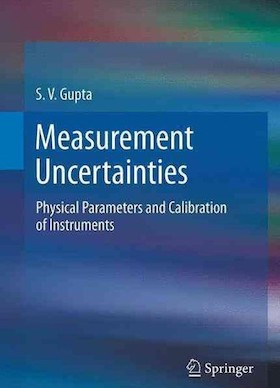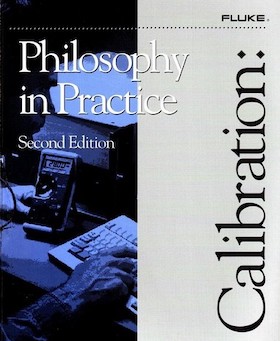
-----
Titration Calibration or Certification?
Q. Hi,
My name is Robin Smith and I am a ceramic engineer, working at plating the end terminals of ceramic capacitors. We plate nickel and tin onto the capacitors. Our medical customer (i.e., parts go into pacemakers, hearing aids, implantable devices) is asking for more calibration and control. Specifically, they are asking for a calibration for plating titrations of our nickel and tin titrations. How is a titration calibrated?
Any suggestions are greatly appreciated.
Sincerely,
Capacitor Manufacturer - Valencia, California
2007
|
A. Yeah... that isn't the easiest to answer directly is it? Compton, California, USA 2007 A. Hi Robin, Process Engineer - Syracuse, New York 2007
"Measurement Uncertainties: Physical Parameters & Calibration of Instruments"
 on eBay or Amazon or AbeBooks (affil link) A. There is an ISO specification that many companies are gradually going to. I think that the number is 15020. - Navarre, Florida 2007 2007 A. One common method is the known addition, whereby you make a standard addition of the component being measured to the sample after the titration is performed and then further titrate to the new endpoint. For example, when looking to measure % HCl, you would titrate the sample to the endpoint, make a known addition of HCl, then titrate further to the new endpoint. You can then calculate the % recovery of the known addition as a QC indicator of the titration.  James Totter, CEF - Tallahassee, Florida A. I've been in your situation before and have a few ideas that may be useful. First, have you tried convincing your customer that this process doesn't require calibration? If your glassware is like mine it has a qualification marked on it; mine has TD 20C, meaning it's set To Deliver the marked volume at a temperature of 20C. As long as your pipettes and burettes are not chipped or broken they are designed to maintain their volumes and don't need to be calibrated. The titration method is based on a chemical reaction that hasn't changed in recorded chemical history. Therefore there isn't anything that can fall out of calibration, so the process doesn't require calibration. - Orland Park, Illinois, USA 2007 A. A Certificate of Analysis (C of A) for the standard EDTA you use might do for documentation.  Dave Wichern Consultant - The Bronx, New York 2007 A. Robin  Geoff Smith Hampshire, England 2007 A. Robin, - Auburn, Washington 2007 |
A. To standardise a titration, you begin with known concentrations of solutions that you will titrate against each other. This is fundamental analytical chemistry. All solutions are made up freshly to precisely known concentrations. The simplest one to do is to titrate N/10 sulfuric acid against N/10 sodium hydroxide. The sulfuric acid is the standard and this is used to find the exact concentration of sodium hydroxide. The problem with sodium hydroxide is that is absorbs carbon dioxide from the air to form sodium carbonate, so the concentration of sodium hydroxide will alter with time. You need to ensure that the solutions you will use for titrating the nickel and tin baths are standardised. Decide which ones are the important ones and then accurately make up known concentrations of these reagents. Compare them with the relevant standard solutions suitable for your analyses.
There is, of course, an alternative and that is to use either AA or ICP analysis. In both cases, start with an accurately known solution that is about 2-3 times the strength of your working (i.e., analysis) samples. Then accurately dilute this solution a number of times and use these diluted solutions as your calibration standards of the AA or ICP. You can then put a sample of your plating solution into the AA or ICP and see what adsorption you get and compare it to your calibration graph. In the case of nickel, I suggest you use nickel sulphate as the standard because nickel chloride can have different amounts of water of hydration and this will affect your nickel concentration. Similarly, I would use tin sulphate and not tin chloride. As a general guide I would recommend you use analytical standard chemicals, not GPC.

Trevor Crichton
R&D practical scientist
Chesham, Bucks, UK
2007
A. I have just read the contributions to date - none of which would satisfy a chemical process auditor.
Comparing analysis with a standard plating solution is no good - how do you guarantee the accuracy? At best it monitors precision not accuracy.
You cannot use either sulfuric acid or sodium hydroxide to prepare primary standards - both are hygroscopic and NaOH absorbs carbon dioxide. Acids are standardised against sodium carbonate.
Water weighs 1.00g/ml - but only at 4 degrees C. Glassware is certified at 20 °C (27 °C in tropical climes)
Suggesting AA, IPC or an autotitrator is like buying a Formula 1 racing car for a learner driver - in the unlikely event of actually getting the thing to work, you just head for disaster that much faster. (Many people seem to suggest IPC but I have yet to see one in regular use and AA can explode if you get the flame conditions wrong!)
To be practical:
Get a copy of "Analysis of Electroplating and Related Solutions", Langford, Published by Draper.
Get a copy of any analysis sheets from your plating process supplier.
Get your balance calibrated; use the leveling device. (If you buy your titration standards you may not need a balance)
Learn to use a pipette properly - this is important
Buy certified purity chemicals and titration standards
B grade glassware is sufficiently accurate - but it must be marked.
Record; Method of analysis, bath, date, results, calculations, additions to the bath, bath dilutions dumps, etc.
Plot a graph of concentration for all constituents and investigate any unexpected fluctuations.
Take a representative sample for analysis; top up the bath to a standard volume and mix well before taking the sample.
OR - you could just send a regular sample to either your supply house or an accredited lab for analysis.

Geoff Smith
Hampshire, England
Q, A, or Comment on THIS thread -or- Start a NEW Thread
